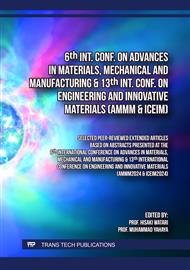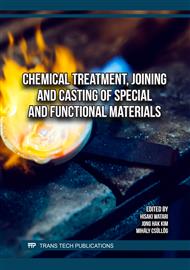[1]
Xie, S., et al., CO2 Reduction to Methanol in the Liquid Phase: A Review. ChemSusChem, 2020. 13(23): pp.6141-6159.
Google Scholar
[2]
Iqbal, F., et al., Photocatalytic reduction of CO2 to methanol over ZnFe2O4/TiO2 (p–n) heterojunctions under visible light irradiation. Journal of Chemical Technology & Biotechnology, 2020. 95(8): pp.2208-2221.
Google Scholar
[3]
Shehzad, N., et al., A critical review on TiO2 based photocatalytic CO2 reduction system: Strategies to improve efficiency. Journal of CO2 Utilization, 2018. 26: pp.98-122.
DOI: 10.1016/j.jcou.2018.04.026
Google Scholar
[4]
Rajaitha, P.M., et al., Unraveling highly efficient nanomaterial photocatalyst for pollutant removal: a comprehensive review and future progress. Materials Today Chemistry, 2022. 23: p.100692.
DOI: 10.1016/j.mtchem.2021.100692
Google Scholar
[5]
Nguyen, T.P., et al., Recent Advances in TiO(2)-Based Photocatalysts for Reduction of CO(2) to Fuels. Nanomaterials (Basel), 2020. 10(2).
Google Scholar
[6]
Tadesse, A., et al., Synthesis of nitrogen doped carbon quantum dots/magnetite nanocomposites for efficient removal of methyl blue dye pollutant from contaminated water. RSC Advances, 2018. 8(16): pp.8528-8536.
DOI: 10.1039/c8ra00158h
Google Scholar
[7]
Humayun, M., et al., Modification strategies of TiO2 for potential applications in photocatalysis: a critical review. Green Chemistry Letters and Reviews, 2018. 11(2): pp.86-102.
DOI: 10.1080/17518253.2018.1440324
Google Scholar
[8]
Abdullah, H., et al., Modified TiO2 photocatalyst for CO2 photocatalytic reduction: An overview. Journal of CO2 Utilization, 2017. 22: pp.15-32.
DOI: 10.1016/j.jcou.2017.08.004
Google Scholar
[9]
Shan, C. and Z. Zhigang, Carbon Quantum Dots: A Component of Efficient Visible Light Photocatalysts, in Visible-Light Photocatalysis of Carbon-Based Materials, Y. Yunjin, Editor. 2017, IntechOpen: Rijeka. p. Ch. 4.
DOI: 10.5772/intechopen.70801
Google Scholar
[10]
Wang, X., et al., A Mini Review on Carbon Quantum Dots: Preparation, Properties, and Electrocatalytic Application. Frontiers in Chemistry, 2019. 7.
Google Scholar
[11]
Kang, C., et al., A Review of Carbon Dots Produced from Biomass Wastes. Nanomaterials (Basel), 2020. 10(11).
Google Scholar
[12]
Al Mayyahi, A., et al., Enhanced charge separation in TiO2/nanocarbon hybrid photocatalysts through coupling with short carbon nanotubes. RSC Advances, 2021. 11(19): pp.11702-11713.
DOI: 10.1039/d1ra00045d
Google Scholar
[13]
Liu, K., et al., Photocatalytic Activity of Phosphorus and Nitrogen Co-Doped Carbon Quantum Dots/TiO2 Nanosheets. Nano, 2020. 15(12): p.2050151.
DOI: 10.1142/s1793292020501519
Google Scholar
[14]
Song, J.-h., et al., The effect of doping temperature on the nitrogen-bonding configuration of nitrogen-doped graphene by hydrothermal treatment. RSC Advances, 2017. 7(34): pp.20738-20741.
DOI: 10.1039/c6ra26426c
Google Scholar
[15]
Jamila, G.S., et al., Pivotal role of N and Bi doping in CQD/Mn3O4 composite structure with outstanding visible photoactivity. New Journal of Chemistry, 2020. 44(27): pp.11631-11642.
DOI: 10.1039/d0nj01457e
Google Scholar
[16]
Wang, Y., et al., Novel metal doped carbon quantum dots/CdS composites for efficient photocatalytic hydrogen evolution. Nanoscale, 2019. 11(4): pp.1618-1625.
DOI: 10.1039/c8nr05807e
Google Scholar
[17]
Nie, H., et al., Carbon Dots with Continuously Tunable Full-Color Emission and Their Application in Ratiometric pH Sensing. Chemistry of Materials, 2014. 26: p.3104–3112.
DOI: 10.1021/cm5003669
Google Scholar
[18]
Jia, J., et al., Facile and Efficient Fabrication of Bandgap Tunable Carbon Quantum Dots Derived From Anthracite and Their Photoluminescence Properties. Frontiers in Chemistry, 2020. 8.
DOI: 10.3389/fchem.2020.00123
Google Scholar
[19]
Zheng, S., et al., Up-converted nitrogen-doped carbon quantum dots to accelerate charge transfer of dibismuth tetraoxide for enhanced full-spectrum photocatalytic activity. Colloids and Surfaces A: Physicochemical and Engineering Aspects, 2021. 615: p.126217.
DOI: 10.1016/j.colsurfa.2021.126217
Google Scholar
[20]
Chung Hui, K., W. Lun Ang, and N. Soraya Sambudi, Nitrogen and bismuth-doped rice husk-derived carbon quantum dots for dye degradation and heavy metal removal. Journal of Photochemistry and Photobiology A: Chemistry, 2021. 418: p.113411.
DOI: 10.1016/j.jphotochem.2021.113411
Google Scholar
[21]
Sharma, S., et al., Fabrication of novel carbon quantum dots modified bismuth oxide (α-Bi2O3/C-dots): Material properties and catalytic applications. Journal of Colloid and Interface Science, 2019. 533: pp.227-237.
DOI: 10.1016/j.jcis.2018.08.056
Google Scholar
[22]
Devi, S., et al., Synthesis and characterization of highly luminescent N-doped carbon quantum dots for metal ion sensing. Integrated Ferroelectrics, 2018. 186(1): pp.32-39.
DOI: 10.1080/10584587.2017.1369322
Google Scholar
[23]
Nugraha, M.W.S., Nonni Soraya; Kasmiarno, Laksmi Dewi; Kamal, Norashikin Ahmad, The Effect of Amino-functionalization on Photoluminescence Properties of Sugarcane Bagasse-derived Carbon Quantum Dots. ASEAN Journal of Chemical Engineering, 2021. 21(1): pp.62-72.
DOI: 10.22146/ajche.61234
Google Scholar
[24]
Astuti, A., et al., Synthesis of α-Bismuth oxide using solution combustion method and its photocatalytic properties. IOP Conference Series: Materials Science and Engineering, 2016. 107: p.012006.
DOI: 10.1088/1757-899x/107/1/012006
Google Scholar
[25]
Mardiana, L., et al., Synthesis TiO2 using sonochemical method and responses the CO2 gas of the nanoparticle TiO2 layers on the QCM sensor surfaces. Journal of Physics: Conference Series, 2022. 2165(1): p.012014.
DOI: 10.1088/1742-6596/2165/1/012014
Google Scholar
[26]
Dubey, R.S. and S. Singh, Investigation of structural and optical properties of pure and chromium doped TiO2 nanoparticles prepared by solvothermal method. Results in Physics, 2017. 7: pp.1283-1288.
DOI: 10.1016/j.rinp.2017.03.014
Google Scholar
[27]
Martins, N.C.T., et al., N-doped carbon quantum dots/TiO2 composite with improved photocatalytic activity. Applied Catalysis B: Environmental, 2016. 193: pp.67-74.
DOI: 10.1016/j.apcatb.2016.04.016
Google Scholar
[28]
Wongso, V., et al., Silica–carbon quantum dots decorated titanium dioxide as sunlight-driven photocatalyst to diminish acetaminophen from aquatic environment. Journal of Photochemistry and Photobiology A: Chemistry, 2020. 394: p.112436.
DOI: 10.1016/j.jphotochem.2020.112436
Google Scholar
[29]
Heryanto, H. and D. Tahir, Composite Fayalite with 5% Laterite Soil and Iron Sand: Structural Properties and Band Gap Calculation Based on Theoretical Kubelka–Munk, Taylor Expansion, and Self-Consistent Field Method. JOM, 2023.
DOI: 10.1007/s11837-023-05828-0
Google Scholar
[30]
Hui, K.C., et al., Effects of nitrogen/bismuth-doping on the photocatalyst composite of carbon dots/titanium dioxide nanoparticles (CDs/TNP) for enhanced visible light-driven removal of diclofenac. Chemosphere, 2022. 290: p.133377.
DOI: 10.1016/j.chemosphere.2021.133377
Google Scholar
[31]
Aghamali, A., et al., Preparation of novel high performance recoverable and natural sunlight-driven nanocomposite photocatalyst of Fe3O4/C/TiO2/N-CQDs. Materials Science in Semiconductor Processing, 2018. 87: pp.142-154.
DOI: 10.1016/j.mssp.2018.07.018
Google Scholar
[32]
Seifi, S., et al. Microstructure of Dry Mortars without Cement: Specific Surface Area, Pore Size and Volume Distribution Analysis. Applied Sciences, 2023. 13.
DOI: 10.3390/app13095616
Google Scholar
[33]
Teymoorian, T., et al., N, S doped carbon quantum dots inside mesoporous silica for effective adsorption of methylene blue dye. SN Applied Sciences, 2021. 3(3): p.305.
DOI: 10.1007/s42452-021-04287-z
Google Scholar
[34]
Francesca, S., et al., Mesoporous TiO2 Thin Films: State of the Art, in Titanium Dioxide, Y. Dongfang, Editor. 2018, IntechOpen: Rijeka. p. Ch. 3.
Google Scholar
[35]
Wang, Y., et al., Unique hole-accepting carbon-dots promoting selective carbon dioxide reduction nearly 100% to methanol by pure water. Nature Communications, 2020. 11(1): p.2531.
DOI: 10.1038/s41467-020-16227-3
Google Scholar
[36]
Li, H., X. Zhang, and D.R. MacFarlane, Carbon Quantum Dots/Cu2O Heterostructures for Solar-Light-Driven Conversion of CO2 to Methanol. Advanced Energy Materials, 2015. 5(5): p.1401077.
DOI: 10.1002/aenm.201570024
Google Scholar



